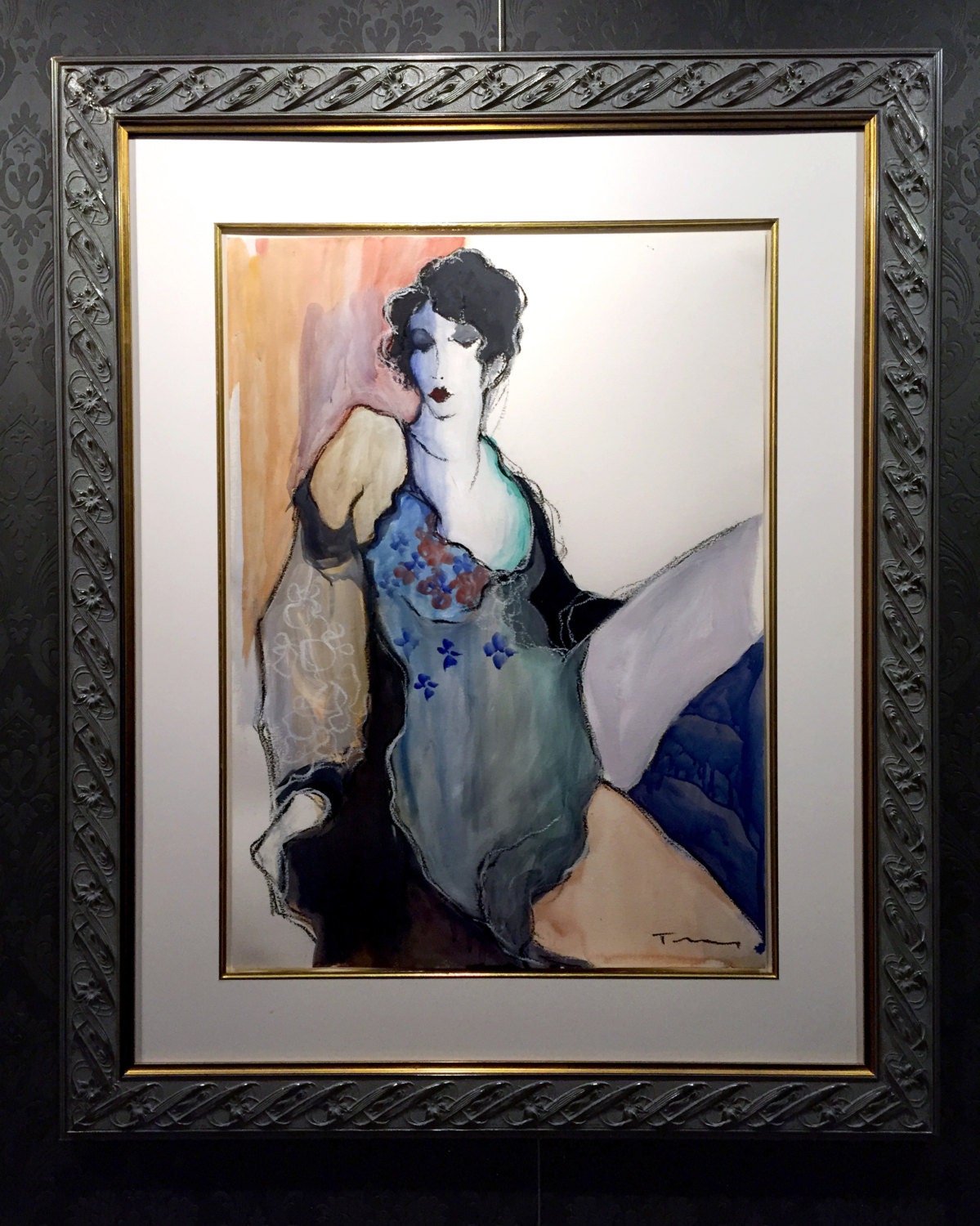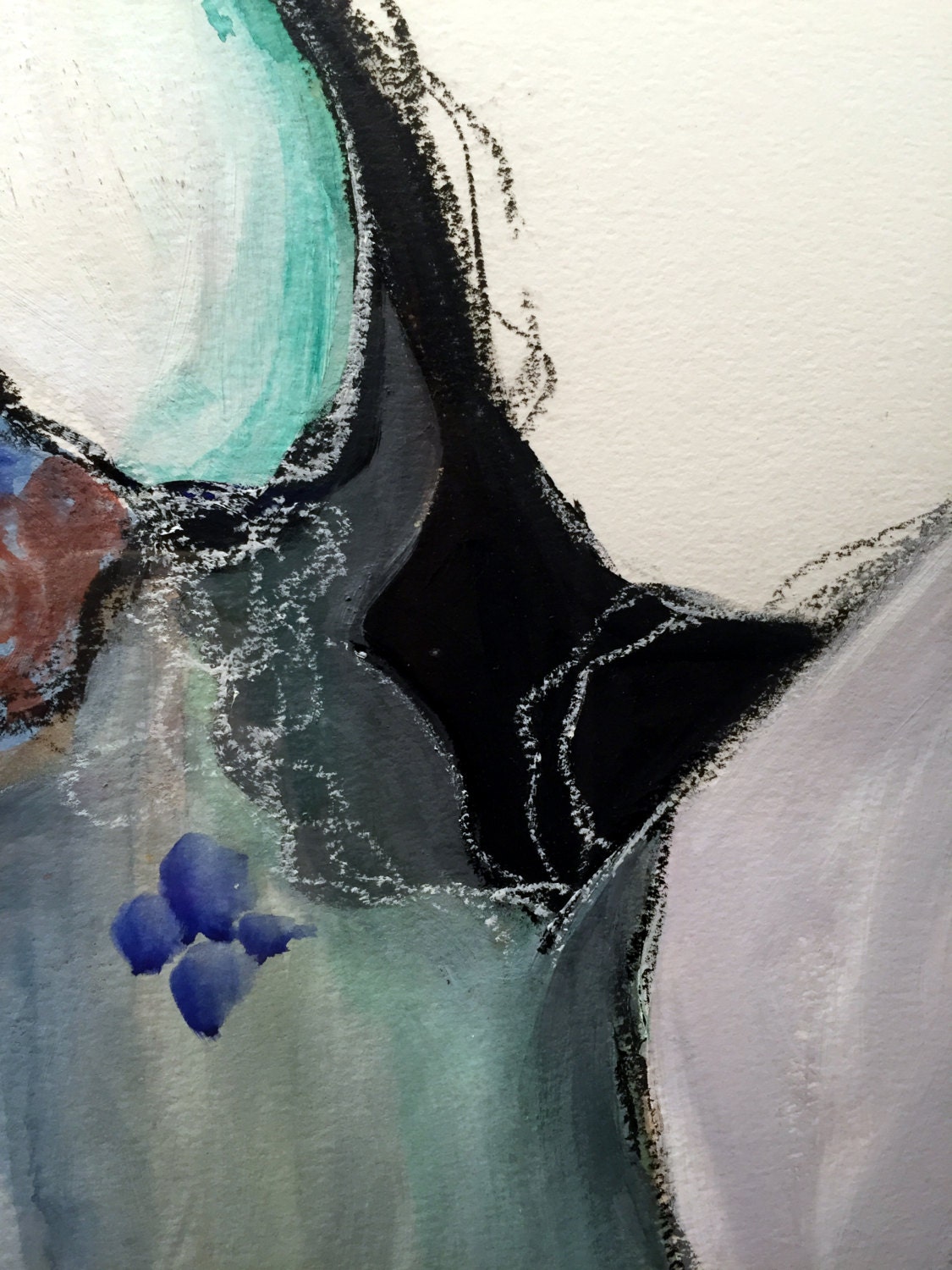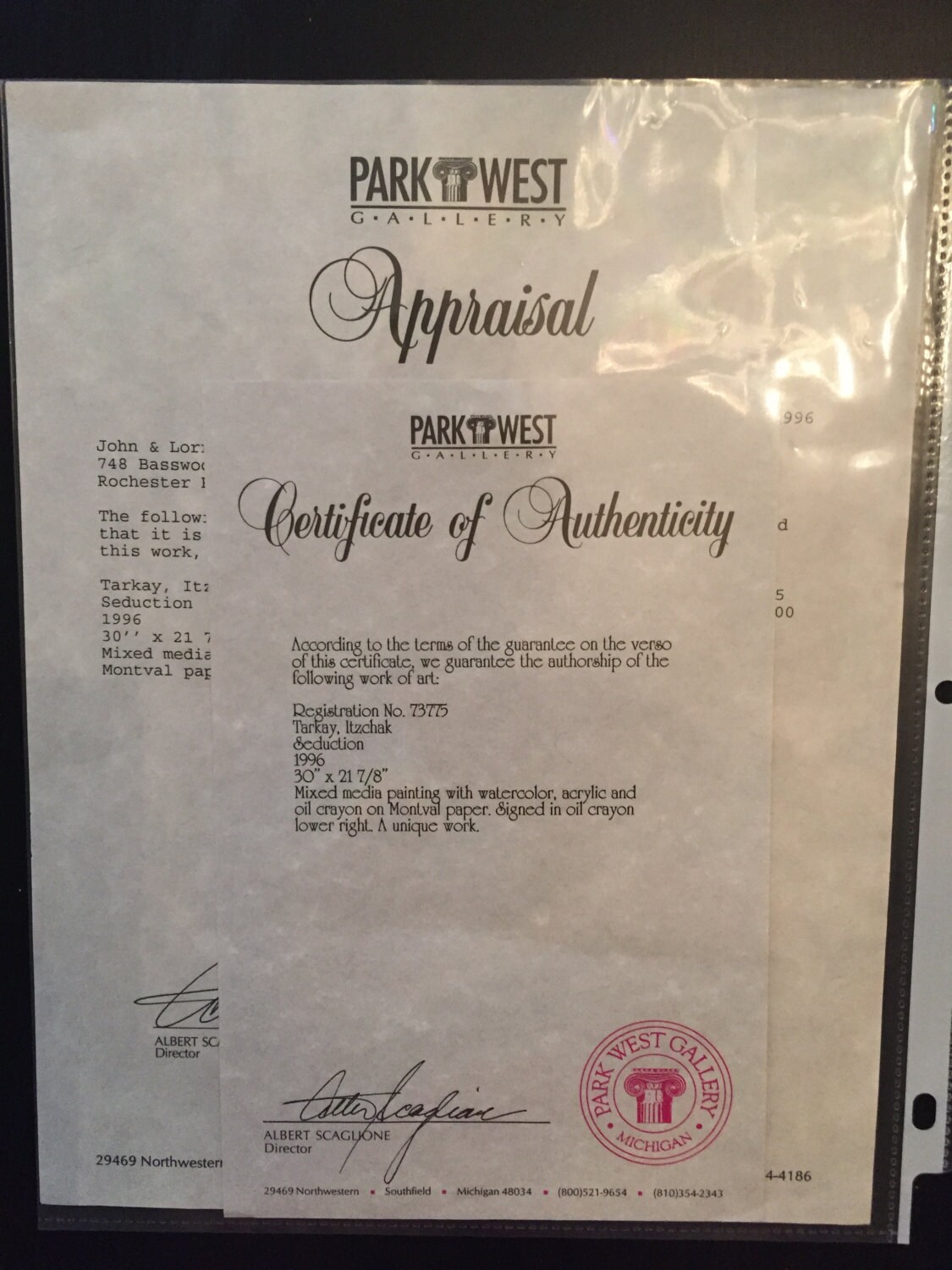Itzchak TARKAY "Seduction" Original PAINTING 1996, COA and Appraisal Park West
$11,000.00
Itzchak TARKAY
"Seduction"
Original Painting
A UNIQUE WORK
Original Painting by ITZCHAK TARKAY
MIXED MEDIA PAINTING with Watercolor, Acrylic and Oil crayon on Montreal paper. Signed in oil crayon lower right.
A UNIQUE WORK.
ORIGINAL Paperwork from PARK WEST Gallery (Certificate of Authenticity and Appraisal)
Professional ORIGINAL Framing, Framing also Signed on the back by TARKAY.
This Artwork is very outstanding and unique, not like any others.
One of the most important artist's pieces.
Framed size : 44 X 36 inch
Painting : 30 X 21 7/8 inch
Professionally Framed and ready to hang. Original Framing is not brand new and could have signs of wear, looks great overall, please consider complimentary to the artwork, sold as is.
Today, Itzchak Tarkay is consdered one of the most influential artists of the early 21st century and has inspired dozens of artists throughout the world.
Unlike so many artists working today, Tarkay believes in Painting and he believes in beauty. Aesthetics and human psychology are the forces that drive his art, not vogue. He has no need of video, mixed-media installation or site-specific sculpture, all of which are the rage of such art centers as New York, Los Angeles, London, Paris, Milan. Instead he makes art "The old-fashioned way" - applying paint to canvas, or printer's inc to paper. In other words , he makes the art of the future - the art that artists invariably come back to, the art that lasts and holds up to the test of time.
...It is clear that Tarkayis thoroughly grounded in European Artistic Traditions. There are touches of Bonnard, Vuillard, Picasso, Modigliani, Klimt, and Magritte in his art. His work, however, does not look like that of any of these Masters. But he shares many of their aesthetic values, and in particular, the idea that art should not proselytize or preach, but instead should deal with timeless issues.
Itzchak Tarkay
tzchak Tarkay (1935 – June 3, 2012) was an Israeli artist.
Tarkay was born in 1935 in Subotica on the Yugoslav-Hungarian border. In 1944, Tarkay and his family were sent to the Mauthausen Concentration Camp, until Allied liberation freed them a year later. In 1949 his family emigrated to Israel, living in a kibbutz for several years. Tarkay attended the Bezalel Academy of Art and Design from 1951, and graduated from the Avni Institute of Art and Design in 1956.
His art is influenced by French Impressionism, and Post-Impressionism, particularly Matisse and Toulouse-Lautrec. His work was exhibited at the International Art Expo in New York in 1986 and 1987. He has been the subject of three books, published by Dr.Israel Perry. Perry Art Gallery And Park West Gallery, his dealer.
His art is focussed on almost dream images of elegant women in classical scenes which draw you into an imaginary world.
History quoted from the website of his dealer, Park West Galleries: "Itzchak Tarkay was born in 1935 in Subotica on the Yugoslav-Hungarian border. At the age of 9, Tarkay and his family were sent to the Mathausen Concentration Camp by the Nazis until Allied liberation freed them a year later. In 1949 his family immigrated to Israel and was sent to the transit camp for new arrivals at Beer Yaakov. They lived in a kibbutz for several years and in 1951 Tarkay received a scholarship to the Avni Art Academy where he studied under the artist Schwartzman and was mentored by other important Israeli artists of the time such as Mokady, Janko, Streichman and Stematsky.
Tarkay achieved recognition as a leading representative of a new generation of figurative artists. The inspiration for his work lies with French Impressionism and Post-Impressionism, particularly the color sophistication of Matisse and the drawing style of Toulouse-Lautrec. He drew upon the history of art to create many of his compositions, designing a kind of visual poetry from the aura of his cafes and intimate settings.
As well as being an acrylic painter and watercolorist, Tarkay was a master graphic artist and his rich tapestry of form and color was achieved primarily through the use of the serigraph. In his serigraphs, many colors are laid over one another and used to create texture and transparency.
When asked about his technique, Tarkay said it’s impossible to describe. “Can you explain your own handwriting?” he asked. He used his instinct to choose his colors and couldn’t define any other reason. “The color is coming,” he said. “When it’s finished, sometimes I’ll change the colors. It’s not something I think about.”
Most of his choices were instinctive – inspired by his surroundings, the music he listened to, the places where he traveled and nature. Very often, Tarkay painted “en plein air” and brought his sketchbook outdoors. As it grew dark, he would take a series of photos and finish the work in his studio. Tarkay said that the most difficult part of his painting is realizing when a work is complete. He recalled going to a show once after he had not seen his paintings in about three months, having the urge to re-touch each piece. To him, the works were never done.
In the later years of his life, Tarkay shared his gifts by mentoring younger Israeli artists including, David Najar, Yuval Wolfson and Mark Kanovich who often visited his studio, worked alongside him and received his critiques. Tarkay was also the only artist to collaborate with Israeli master, Yaacov Agam (1928). He and Agam created two paintings which incorporated both artists’ imagery in a single painting.
Tarkay spent between five and six hours each day in the studio, six days a week. While he had very little free time, he enjoyed going to concerts, reading books and listening to music, and visiting friends. Tarkay expressed how much he enjoyed meeting his collectors and his happiness to work with the other artists when working with Park West. He felt no sense of competition with them – only love – and was proud to have such a wonderful relationship with the artists, collectors, and gallery.
In an excerpt from “Itzchak Tarkay” (1993) by art historian, author, and critic, Joseph Jacobs, PhD, the author writes:
Itzchak Tarkay is a refreshing anomaly in today’s art world, and perhaps it can even be said that his work, which seems to stand outside of the mainstream, nonetheless anticipates the direction of art in the near future. In a world so preoccupied with being politically correct, with dealing with social issues, with making art that is anything but painting, Tarkay holds onto timeless, universal values–to values that have staying power and do not simply ride the tide of fashion. In contrast to the work of so many of his contemporaries, it will be impossible to look back on his work in the twenty-first century and describe it as dated.



